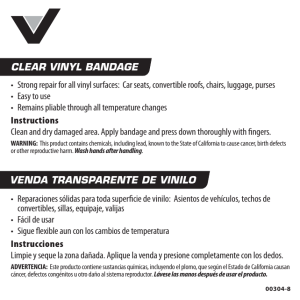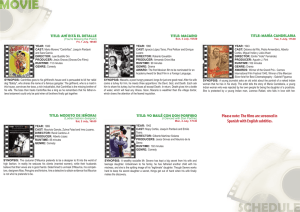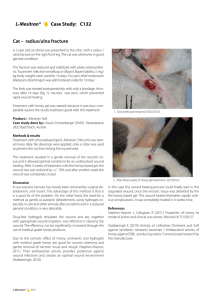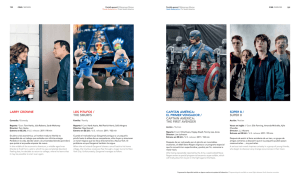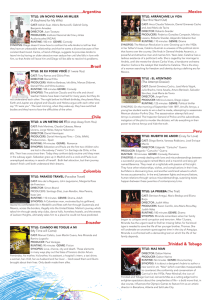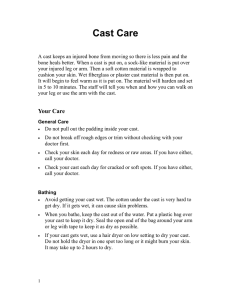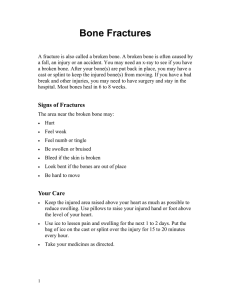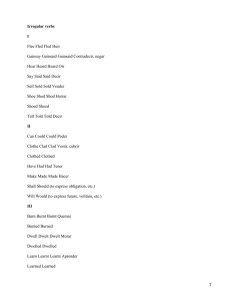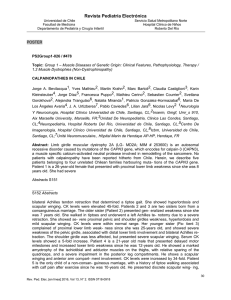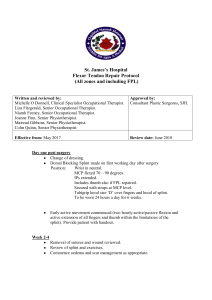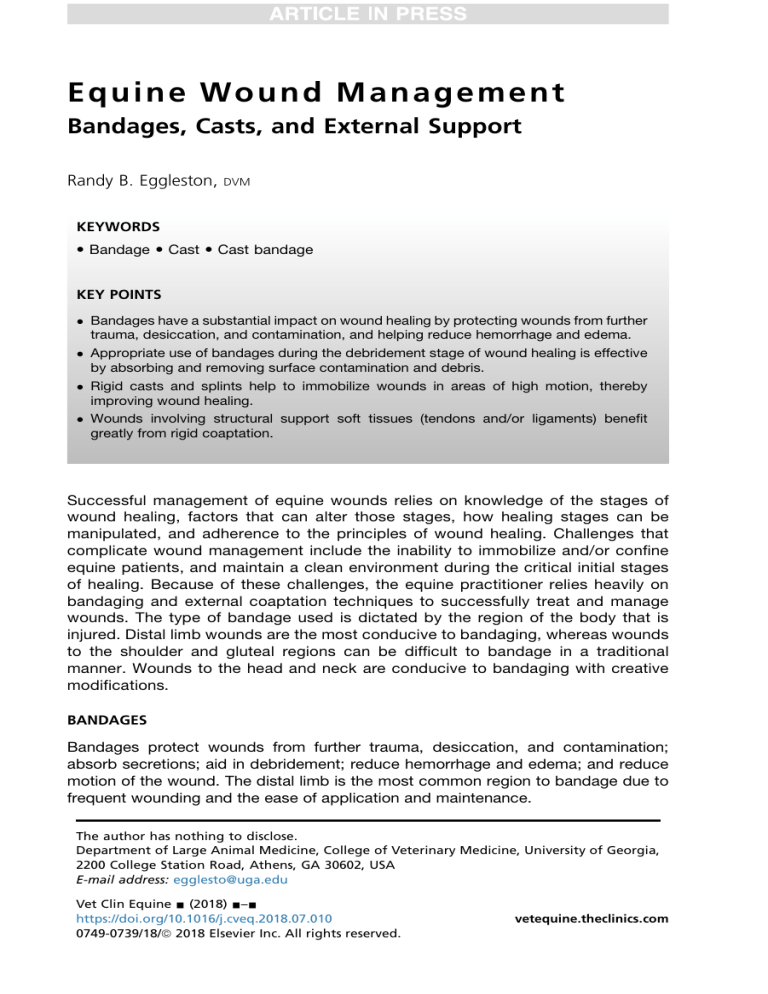
E q u i n e Wo u n d M a n a g e m e n t Bandages, Casts, and External Support Randy B. Eggleston, DVM KEYWORDS Bandage Cast Cast bandage KEY POINTS Bandages have a substantial impact on wound healing by protecting wounds from further trauma, desiccation, and contamination, and helping reduce hemorrhage and edema. Appropriate use of bandages during the debridement stage of wound healing is effective by absorbing and removing surface contamination and debris. Rigid casts and splints help to immobilize wounds in areas of high motion, thereby improving wound healing. Wounds involving structural support soft tissues (tendons and/or ligaments) benefit greatly from rigid coaptation. Successful management of equine wounds relies on knowledge of the stages of wound healing, factors that can alter those stages, how healing stages can be manipulated, and adherence to the principles of wound healing. Challenges that complicate wound management include the inability to immobilize and/or confine equine patients, and maintain a clean environment during the critical initial stages of healing. Because of these challenges, the equine practitioner relies heavily on bandaging and external coaptation techniques to successfully treat and manage wounds. The type of bandage used is dictated by the region of the body that is injured. Distal limb wounds are the most conducive to bandaging, whereas wounds to the shoulder and gluteal regions can be difficult to bandage in a traditional manner. Wounds to the head and neck are conducive to bandaging with creative modifications. BANDAGES Bandages protect wounds from further trauma, desiccation, and contamination; absorb secretions; aid in debridement; reduce hemorrhage and edema; and reduce motion of the wound. The distal limb is the most common region to bandage due to frequent wounding and the ease of application and maintenance. The author has nothing to disclose. Department of Large Animal Medicine, College of Veterinary Medicine, University of Georgia, 2200 College Station Road, Athens, GA 30602, USA E-mail address: [email protected] Vet Clin Equine - (2018) -–https://doi.org/10.1016/j.cveq.2018.07.010 0749-0739/18/ª 2018 Elsevier Inc. All rights reserved. vetequine.theclinics.com 2 Eggleston The standard distal limb bandage/wrap is composed of 3 layers: primary, secondary, and tertiary. Each layer serves a specific purpose important to the management of the wound. Primary Layer The primary layer is the most influential layer, as it is in contact with wounded tissues. It can be modified in a number of ways to fit the stage of healing and have the most appropriate effect on the wound. The primary layer can also be harmful to the wound if not used appropriately. The primary layer is classified with respect to the material used, gas and fluid exchange, and the ability of the material to adhere to the wound.1–3 Synthetic, semisynthetic, or biologic Occlusive, semiocclusive, or nonocclusive Adherent or nonadherent A synthetic, nonocclusive, or semiocclusive primary layer is the most commonly used for equine wounds. Occlusive dressings are best used in the first 3 to 5 days of healing, as they promote the formation of granulation tissue and delay healing time.4 An exception to this is the use of synthetic, nonadherent occlusive silicone dressings. Silicone dressings are used extensively in human medicine to reduce scar formation.5,6 In a study in horses, a silicone-containing dressing outperformed a conventional dressing, resulting in the prevention of exuberant granulation tissue formation and improved tissue quality.7 The primary layer can be modified in a number of ways to achieve its desired effects on a particular wound, as it is in direct contact with the wound and plays a major role in the progression of healing (Fig. 1). The stage of wound healing dictates the chosen composition of the primary layer. In the initial debridement stage of healing, adherent bandages are indicated where large quantities of necrotic tissue and thick exudate are present. Suggested materials are wide meshed sterile gauze, such as 4 4 gauze sponges, which are highly absorbent and allow incorporation of large particles into the mesh of the gauze. Adherent bandages can be further classified as Dry-to-Dry, Wet-to-Dry, or Wet-to-Wet.1 Dry-to-Dry bandages are used when the wound surface Fig. 1. (A) Primary layer composed of a nonadherent dressing held in place by sterile 4-inch Kling gauze. (B) Secondary layer composed of 5 layers of sheet cotton held in place with 6-inch brown gauze. (C) Tertiary layer composed of 4-inch elastic Vet Wrap. The proximal and distal end of the bandage have been sealed with 4-inch elastic adhesive Elastikon tape. Equine Wound Management contains large quantities of loose tissue and low viscous exudate. A layer of dry sterile gauze is placed on the wound with overlying secondary and tertiary layers and left in place until the unwanted material is absorbed and the primary layer is dry. The bandage is then removed, debriding the wound as the gauze is elevated. Removing the primary layer may be painful for a horse and light sedation may be required. Lightly wetting the gauze can help loosen the material and make removal less painful. If additional debridement is necessary, reapplication of a Dry-to-Dry bandage can be done. Wet-to-Dry bandages are indicated for desiccated wounds that contain dried, viscous, and necrotic material.2 The moisture of the primary layer helps to soften and loosen the unwanted material and allows it to be absorbed into the mesh of the bandage, and the wound site can be debrided with bandage removal. The primary layer is lightly moistened with sterile saline or an antibacterial solution. If an antibacterial solution is desired, appropriate concentrations should be used (chlorhexidine 0.05%, povidone iodine 0.1%). The bandage is removed once the primary layer has dried. The Wet-to-Dry layer should not be oversaturated; excessive moisture can allow wicking of bacteria through the secondary and tertiary layers. Maceration of the surrounding tissues may also occur. Wet-to-Wet bandages have little debriding capability. They are indicated for wounds with a large quantity of viscous exudate that lack marked debris and necrotic tissue. Wet-to-Wet bandages are effective at diluting and thinning the exudate, making removal easier. The primary layer is applied wet and is removed wet. A sterile fluid or antimicrobial solution can be used as the wetting agent. The quantity of fluid used should be more than that used for a Wet-to-Dry bandage. Nonadherent bandages are used when the wound has been satisfactorily debrided. This implies that wound fibroplasia and epithelialization are occurring, and protection of the new granulation tissue and epithelium should be taken into consideration. A nonadherent Telfa (Covidien Ltd. Co., Dublin, Ireland) is a semiocclusive bandage that retains enough moisture to prevent wound dehydration and promote epithelialization. Any excess fluid from the wound also can be absorbed, preventing tissue maceration.2 Secondary Layer The secondary bandage layer is primarily an absorptive layer and adds protection to the wound. This layer absorbs and stores excess drainage of blood, serum, exudate, and necrotic tissue from the wound surface.3 Secondary layers are usually composed of sheet or roll cotton. The bandage should be of sufficient thickness to adequately absorb and retain the excess fluid and provide a pad over the wound. Three to 4 layers of sheet cotton folded in half, or 2 complete layers of roll cotton, are adequate for most wounds (see Fig. 1). This layer should fit snuggly, but not so tight that absorption is hindered. Tertiary Layer The tertiary layer is the holding layer of the bandage. It is composed of an adhesive tape (Elastikon; Johnson & Johnson, New Brunswick, NJ) or self-bonding material (Vet Wrap [3M Corporation, St. Paul, MN], Co-Flex [Andover Medical, Salisbury, MA]) (see Fig. 1). The tertiary layer can be applied with varying pressure. Depending on the type and location of the wound, the tertiary layer can supply some degree of immobilization when applied under pressure. The secondary layer should be of sufficient thickness if the tertiary layer is to be applied under semi-immobilizing pressure. A tightly applied tertiary layer without adequate padding from the secondary layer can cause tissue damage to the skin and underlying tissues (ie, flexor tendons). The tertiary layer can be applied with moderate pressure without causing danger to the underlying soft tissues, provided 4 to 5 sheets of the sheet cotton or an equivalent 3 4 Eggleston material are used. The bandage should be wrapped in the same direction as the primary and secondary layers, otherwise loosening of the bandage will occur. It is important to apply each turn of the wrap with the same amount of pressure. Areas of eccentrically concentrated pressure can cause soft tissue trauma at those areas. A second tertiary layer can be applied if marked edema is present. Six-inch nonelastic brown gauze works well to supply an even distribution of pressure throughout the wrap. Elastikon can be applied to the top and bottom of the bandage to eliminate further contamination with bedding material. SPECIFIC BANDAGES Stack Bandage (Full-Limb Bandage) A stack bandage is commonly used for wounds of the upper limb and to address whole-limb edema (Fig. 2). A stack bandage is simply a bandage stacked proximally Fig. 2. Stack bandage is indicated for treating wounds to the carpus or proximal and wholelimb swelling. Equine Wound Management on top of a distal limb bandage. The distal portion of the bandage helps to maintain the upper portion of the bandage in place. Because of the narrowing distal anatomy of the front limb, maintaining an upper limb bandage can be difficult. A tightly placed upper limb bandage can also induce edema formation in the distal limb. Applying a stack bandage is an effective alternative. Stack wraps also supply padding to the limb when rigid splints are used. Carpal Bandage Bandaging wounds of the carpus can be difficult. Use of a stack bandage is one method. Using an adhesive elastic bandage for the tertiary layer is another method. The primary and secondary layers can be applied in similar fashion to a distal limb bandage. The tertiary layer is started well proximal to the secondary layer to achieve adequate anchor to the haired skin of the antebrachium with the adhesive bandage. Elastikon is commonly used. The elastic adhesive tertiary layer should be loosely applied to the skin, and the desired pressure can be applied throughout the secondary layer. When bandaging the carpus, pressure over the accessory carpal bone is a concern. A releasing cut through the tight bandage layers over the accessory carpal bone will relieve the pressure and aid in preventing pressure sores at the site (Fig. 3). Tarsal Bandage The tarsus also can be a challenge to bandage. Bandage slippage is usually not a problem because of the angle of the hock. Constriction at the point of the common calcaneal tendon and pressure concentration at the point of the hock (calcaneus) are potential problems. Application of a tarsal bandage is similar to a distal limb bandage. When applying the secondary layer, the bandage material should stay aligned with the distal tibia. The material should be pulled taught, pressed flat, and folded evenly over the medial aspect of the tarsus. This will create a smooth, nonwrinkled bandage (Fig. 4). The tertiary layer can be applied in a figure of 8 pattern around the point of the hock to reduce pressure over the calcaneus. If complete Fig. 3. Carpal bandage. (A) An adhesive tertiary layer can help secure to the carpus and prevent slippage. (B) Releasing incision over the accessory carpal bone helps to relieve focal pressure over the bone. (C) Pressure sore over the accessory carpal bone due to an improperly placed carpal bandage. 5 6 Eggleston Fig. 4. Tarsal bandage. (A) Sheet colon is unrolled in alignment with the tibia. The excess material plantar to the tarsus is placed under light tension and folded over the medial side, forming a smooth secondary layer. (B) Completed tarsal bandage. The proximal and distal aspect of the bandage is sealed with Elastikon adhesive tape. The Elastikon also helps prevent slippage. coverage is desired, a pressure-releasing cut should be made into the bandage over the point of the hock. CASTS AND SPLINTS Rigid casts or splints are very useful for management of distal limb wounds when complete or limited immobilization is required. Rigid immobilization is indicated for wounds located in high range of movement regions or when the original wound compromises supporting tissues, such as tendons and ligaments.8–11 Foot or phalangeal casts are very effective for acute and chronic heel bulb lacerations, hoof wall avulsions, and coronary band trauma.12,13 Casts also can be applied over sheet grafts to help stabilize the graft and reduce shear forces. Casts applied for wound management are constructed and applied similar to rigid casts used for fracture stabilization (Table 1). Casts can be modified to accommodate the wound management plan. Extensive wounds that involve synovial structures, supporting tendon and/or ligaments, or very exudative wounds requiring frequent bandage changes and wound debridement can be stabilized with a cast bandage. A cast bandage is a combination of a standard 3-layer bandage with an overlying rigid cast. Equine Wound Management Table 1 Materials required to construct a standard half-limb cast Material/Manufacture Available Splint Advantages/Disadvantages Polyvinyl Chloride (PVC) pipe Inexpensive, readily available, customizable, limited applications. Fiberglass casting tape Unlimited constructs, Customizable to multiple applications, single application. VIP (Veterinary Inclusive Prosthetics/Orthotics) Prefabricated and custom orthopedic bracing (Fig. 11) Custom fit, expensive Dynasplint Systems Inc. Prefabricated and custom orthopedic bracing Custom fit, expensive Kimzey Welding Works Kimzey Leg Saver Splints Prefabricated, emergency applications, short-term immobilization of wounds, one size for multiple applications. Red Boot Equine Limb Saver Prefabricated, emergency applications, short-term immobilization of wounds, one size for multiple applications. Similar product was found to be far superior to casting alone. The author uses the above product extensively and finds it to reduce cast sores and improve cast fit. From Bramlage LR, Embertson RM, Libbey CJ. Resin impregnated foam as a cast liner on the distal equine limb. Proc Am Assoc Equine Pract 1991;37:481–5; with permission. Distal limb and phalangeal casts for the front limb can be placed with a horse standing or under general anesthesia. Although possible, application of a distal hind limb cast on a standing horse is difficult and may be more safely done under general anesthesia.14 Distal Limb Cast Application Refer to articles by Elce3 and Auer14 for more detailed description of cast application. Prepare the wound. Place a sterile wound dressing over the wound and hold it in place with cast padding or Kling gauze (Johnson & Johnson). The primary layer should be low mass, as to not result in excessive compression and later cause cast loosening. Use a double layer of stockinet, covering the entire foot and extending above the carpus or tarsus. The stockinet should be snug on the limb to prevent wrinkling beneath the cast. Cut a 2-inch to 4-inch-wide strip of casting felt. Cut it to length so it will fit snugly, but completely, around the proximal metacarpus/metatarsus, approximately 2 to 4 cm below the level of the carpometacarpal/tarsometatarsal joint. Secure the ends with 1-inch or 2-inch-white medical tape. Drill two 4-mm to 5-mm holes through the hoof wall at the toe and place a 12-inch to 24-inch length of wire through the holes and twist the free ends. This will allow an assistant to secure the limb in a stable position and place the fetlock at the desired angle. If being performed in a standing horse, the limb should be held 7 8 Eggleston by an assistant at the level of the distal radius, allowing the distal limb to hang freely out of weight bearing. A second assistant can then apply tension to the toe wire. In a standing horse, it is very important (once cast application is started) that there is no movement in the limb. Limb movement can create wrinkles in the cast and lead to pressure sores. If unable to off-weight the limb, the cast can be applied in the weight-bearing position, similar to applying the foot cast (see later in this article). It is important that the horse remain standing square and not shifting any weight during application, as this will cause potential complications in the fetlock region. (Optional step) Apply a layer of support foam starting at the distal margin of the casting felt; spiraling down the leg, overlapping 50% so there is an even layer throughout. The support foam can be stopped just below the coronary band. This material can be applied under firm tension to prevent wrinkling. A no longer available original product was a resin-impregnated polyurethane foam that was found to be far superior to casting alone.15 That product has been replaced with a dry polyurethane foam with an adhesive backing, which allows for self-adhered secure application (3M Reston Self-Adhering Foam; 3M Corporation). For a half-limb (distal limb) cast, 6 to 7 rolls of 4-inch casting tape are required. Submerse each individual roll in warm water for 10 to 15 seconds. Gently squeeze the tape 3 to 4 times while submersed. Before application, gently ring out excess moisture, leaving the tape moderately wet. Initiate application 1 cm below the top edge of the casting felt. Apply first 2 to 3 wraps directly on top of one another. Spiral the material down the leg, overlapping each wrap by 50%. Timely application is important to prevent premature curing of the material. Most fiberglass casting tapes have a weight-bearing cure time of 20 to 30 minutes. Apply under gentle tension, as not to cause excessive pressure under the cast. Avoid wrinkling or focal finger pressure that may result in pressure points. Initiate second roll 10 to 15 cm proximal to the termination of the first roll. Continue distally to include the foot. Smooth application through the fetlock, pastern, and foot can be difficult. Reversing the direction of application can help. Gently fold the tape over to form the desired direction of application. Once the foot is incorporated, application can continue proximally. Initiate the third roll in similar fashion to the first roll. Following completion of the third roll, fold down excess stockinet evenly, forming a smooth fabric cuff. Continue applying casting tape until you have applied the appropriate 6 to 7 rolls. Depending on the desired fetlock angle, the foot may not stand flat to the ground. To prevent undue pressure at the proximal dorsal aspect of the cast, and to broaden the weight-bearing surface, a single roll of 3-inch casting tape can be conformed to the heel region of the cast to form a heel wedge. Secure the wedge onto the cast with a final roll of casting tape. Once the cast is hardened, a 2-part acrylic (Technovit; Jorgensen Laboratories, Inc., Loveland, CO) is applied to the bottom of the cast to prevent wearing. Mix approximately 8 oz powder with the appropriate volume of solvent to make a thick paste. Pour the mixture onto a 12 12-inch piece of plastic and apply to the bottom of the cast and secure to the foot with white tape. Using this method allows forming the acrylic without direct contact while it sets. Equine Wound Management Apply 2 to 3 loose wraps of Elastikon at the proximal aspect of the cast extending onto the skin. This “seals” the cast from bedding and other debris that might cause tissue irritation. Once the cast is set, the author will stand the horse on a flat, even surface and check the fit of the cast. Ideally, the limb should be centered in the cast with minimal pressure throughout the circumference of the cast. It is common to have pressure along the dorsal rim of the cast. Using an electric hand grinder or a Farrier’s rasp, material can be removed from the bottom of the cast at the toe region. If ample material is not available to remove, the heel can be built up with additional Technovit. Scoring the existing Technovit with the grinder will improve binding of any new material. Cast Bandage A cast bandage is an excellent treatment choice for wounds that would benefit from rigid immobilization but require frequent treatment. A standard 3-layer bandage is first placed on the distal limb. One additional sheet of cotton should be added to the initial bandage. Reapplication of a bivalved cast can be difficult if the desired number of cotton sheets is used for the initial construction of the cast bandage. A standard cast is applied over this bandage. Twenty-four to 48 hours after cast material application, the cast can be cut at the medial and lateral aspects, leaving the solar portion intact. This forms a bivalved splint that can be removed for treatment of the wound. When removing the 2-halves of the cast, the front and back should be gently separated. This will cause the cast to break and hinge at the weight-bearing aspect of the foot. The cast can then be removed distally while the limb is held off the ground. After treatment of the wound, the cast can be carefully replaced on the limb, closed, and secured with a continuous layer of 2-inch medical tape (Fig. 5). Fig. 5. Cast bandage. (A) Horse was placed under general anesthesia to debride a wound involving the metacarpophalangeal joint. Standard 3-layer distal limb bandage has been placed. (B) Standard distal limb fiberglass cast was placed over the bandage and allowed to set. Using a cast saw, the cast was cut at 3:00 and 9:00 position. This will allow the cast to act as a bivalve and be removed for later treatment of the wound. (C) Completed cast bandage. The cast has been compressed and secured with 2-inch white tape. 9 10 Eggleston Fig. 6. EGT as the result of an inappropriately treated heel bulb laceration. Foot Cast Wounds of the pastern, heel bulb, and hoof wall are common injuries in the horse. These wounds present a particular challenge to wound management.12,16,17 Suture closure and maintaining closure of an acute heel bulb laceration is difficult due to location and skin tension. If left to heal by second intention, the formation of exuberant granulation tissue is common and further complicates management (Fig. 6). Application of a mid-pastern foot cast is a very effective method of stabilization and treatment of these injuries.8,12 An acute wound that is not conducive to primary closure can be managed for 7 to 10 days under a bandage,12 which can allow time for debridement and infiltration of healthy granulation tissue. Once covered with granulation tissue, a foot cast can be applied (Fig. 7). An alternative consideration is acute placement of a foot cast once synovial penetration has been ruled out. This can substantially control granulation tissue formation. If communication with a synovial structure is identified, the wound should continue to be managed with a replaceable bandage. Appropriate therapy should be instituted and continued until it can be confirmed that synovial communication no longer exists18 (see Elsa K. Ludwig and Philip D. van Harreveld’s article, “Equine Wounds Over Synovial Structures,” in this issue). Fig. 7. Severe heel bulb laceration. (A) The wound was treated as an open wound and debrided for 7 to 10 days. (B) The same wound as in (A) after 14 days in a foot cast. Equine Wound Management Exuberant granulation tissue (EGT) is often present with chronic distal limb wounds and impedes tissue apposition and normal healing (see Fig. 6). The wound should be assessed and debrided of EGT. The foot can then be placed in a well-padded absorptive bandage for hemostasis. A foot cast can be applied 12 to 24 hours later. A foot cast is applied similarly to a half-limb cast. Depending on the clinician’s preference and the temperament of the horse, the cast can be applied with a horse standing or under general anesthesia.3,8,18 Light sedation is recommended to help prevent movement of the affected limb. A nonadherent primary layer is applied and lightly covered. No additional bandage is necessary. A double layer of stockinet, extending up to the fetlock joint is applied. A 1.5 to 2.0-inch strip of casting felt, around the proximal pastern, is secured with a short strip of 1 to 2-inch white tape. A piece of casting felt can also be placed over the heel bulbs to reduce the risk of pressure sore formation. For added protection, a layer of 3M Reston Self-Adhering Foam (3M Corporation) can be applied (Fig. 8). When applying a cast in a standing horse, it is important to have the distal limb in a natural position and to incorporate a portion of the solar surface of the foot when applying the first 1 to 2 rolls of casting tape. To incorporate the sole, the horse can be stood on a flat board with the palmar/plantar one-half to onethird of the foot overhanging the edge of the board. The board should be of ample height to allow placement of casting tape between the foot and the ground. Fig. 8. Foot cast application. (A) A double layer of stockinet is applied over the foot extending above the fetlock. A strip of casting felt is secured around the proximal pastern. (B) 3M support foam is applied to the pastern and foot (the depicted yellow resin-impregnated foam has been replaced by a dry self-adhesive foam). 11 12 Eggleston Fig. 9. Foot cast application. (A) Two rolls of 4-inch casting tape have been applied to the foot and the excess stockinet has been folded over the proximal rim of the cast. (B) The last roll of casting tape had been applied and the cast is complete. The top of the cast has been sealed with 4-inch Elastikon. (C) Technovit acrylic has been applied to the bottom of the cast to bolster the wear of the cast. Standing the opposite foot on a board of equal height will help keep the limbs square.18 An alternative method is to stand the horse on a wood block that is slightly smaller than the foot. This will allow the entire rim of the hoof and heels to be incorporated in the initial casting. Two roles of 3-inch to 4-inch fiberglass cast material should be applied, starting at the proximal pastern spiraling distally, incorporating as much of the solar surface and heel bulbs as possible. The cast should cover the entire foot and extend to the proximal pastern. When the cast is firm to a point that it will not flex, the limb can be picked up and held by an assistant and the residual stockinet folded over the top rim of the cast and the third roll of casting tape applied to incorporate the remainder of the foot (Fig. 9). To reduce wear of the cast, a layer of Technovit can be applied to the weightbearing surface of the cast. Elastikon can be placed around the proximal cast to prevent debris from entering the cast (see Fig. 9). The cast can be left in place for 2 to 4 weeks, which allows for controlled wound healing. The rules for cast failure do not necessarily apply to this type of application. The foot cast may become soiled and malodorous with exudative strike through due to the underlying wound. As long as there is no lameness associated with the cast, it should remain in place for the duration of treatment. Complications Generally, casts that are applied for the purpose of wound management do not need to be worn longer than 10 to 14 days.3 Wounds involving tendons and ligaments often require longer coaptation. The most common cast-associated complication is skin injury, or decubital cast sores. Other reported complications include fracture of the cast, superficial digital flexor tendon injury, and long-bone fractures. The incidence of cast sores in the literature is reported to be 45% to 81%.19–22 One study reported only an 11% incidence of partial-thickness cast sores, but those horses were in casts for less than 15 days.22 The most common locations for cast sores are the palmar/plantar aspects of the fetlock and the top of the cast.19 It is imperative that cast limbs be carefully evaluated multiple times a day, both visually and with palpation of the entire cast. The top of the Equine Wound Management cast should be evaluated for signs of skin abrasions, moisture, and swelling proximal to the cast. Treatment of visible cast sores includes adjustment of the cast as described earlier, and topical therapy, including a nonadherent dressing with local antimicrobial therapy. Cast sores located within the confines of a cast can be more difficult to identify early. Lameness and a focal increase in temperature at the site of a sore will be the initial clinical signs.21 A recent study looking at the use of thermography for the early detection of cast sores found the severity of the cast sore was positively associated with an increase in the temperature differences between the coolest portion of the cast and the affected area, and that the optimal cutoff values for the presence of a superficial, partial-thickness, sore was 2.3 C (4.1 F), and for a deep sore was 4.3 C (7.7 F).21 As a lesion progresses, the warmth of the affected area will increase. A cast will start to discolor at the affected site due to exudate strike through, and depending on the time of the year, flies may congregate on the cast. As the tissue becomes more abraded and productive, exudate coming from the sore can bubble at the surface of the cast (Fig. 10). Splints Splints, although not as rigid as a fiberglass cast, work very well in the treatment of equine limb wounds. Splints can be used for distal limb immobilization, but a major indication is for immobilization of wounds involving the carpus and tarsus. Full-limb casts can be used for carpal and tarsal wounds, but the inherent increased risk of complications usually makes the use of a splint more appropriate.3,19 Splints can be constructed from various materials at the time of treatment, and prefabricated splints are commercially available. A number of commercially available distal limb splints are available and work well, but can be expensive and many of them are not “one-size-fits-all.” Custom-made braces are also available through a number of orthotic companies (Fig. 11, Table 2). Polyvinyl chloride (PVC) pipe is probably the most widely used material to fabricate splints. Depending on the size of the limb, 6-inch or 8-inch schedule 40 pipe is recommended. The appropriate length is cut and then using a band saw or cast saw the pipe Fig. 10. Examples of cast sores. Note the accumulation of flies at a site of light discoloration of the cast. The image on the right represents a cast sore that has become more productive, resulting in exudate percolating through the cast. 13 14 Eggleston Fig. 11. Example of a commercial custom padded clamshell full-limb splint. The splint is made to conform perfecting to a particular patient and allow access to any underlying wounds. is cut to form 2 equal halves. Less radius can be used, but rigidity will be decreased as width (circumference) decreases. If molding a splint is required to fit the distal limb, a one-third radius cut will work better and still maintain adequate rigidity. Sharp edges can be rounded with a Farrier’s rasp or an electric sander. For immobilization of the carpus, a splint should extend from the proximal radius to the fetlock joint. Once a wound has been addressed, a well-padded stack wrap should be placed over the entire limb. A splint is fitted to the caudal aspect of the limb and held firmly in place with 2-inch white tape. It is important that the full extent of the splint is securely taped. For immobilization of the distal limb, a splint should extend from the proximal metacarpus/tarsus down to the ground. To maintain normal conformation of the fetlock and foot, the splint may need modification or extra bandage material. If PVC material is being used, the distal one-fourth to one-third can be heated and molded to match the fetlock angle. Once the material becomes malleable and the appropriate angle is obtained, dipping the splint into cool water will help speed the hardening time of the splint (Fig. 12). If circumstances prevent molding the splint, the space palmar/plantar to the pastern and heel bulbs can be filled with a rolled towel or bandage material. This will fill that space between the foot and the splint and keep fetlock angles normal. Equine Wound Management Table 2 Examples of available splinting material and manufactured splints Material/Manufacture Available Splint Polyvinyl chloride (PVC) pipe $, easily obtained. Can be easily customized. Limited applications. Fiberglass casting tape $$, unlimited constructs. Can be molded for multiple applications. Generally single application. VIP (Veterinary Inclusive Prosthetics/ Orthotics) Prefabricated and custom $$$ orthopedic bracing (see Fig. 11) Dynasplint Systems Inc. Prefabricated and custom $$$ orthopedic bracing Kimzey Welding Works Kimzey Leg Saver Splints $$, Prefabricated brace marketed for emergency break-down injuries. Works well for short-term immobilization for wound management. One size can fit multiple horses. Red Boot $$$ Equine Limb Saver Fig. 12. PVC pipe molded for a distal limb splint. 15 16 Eggleston Fiberglass casting tape also works well for splint fabrication, and has an advantage over PVC material in that it can be molded to the desired region of the limb resulting in a well-fitted custom splint. The disadvantage is the cost of materials. Technique-1: Measure the desired length of the splint Using 4-inch or 5-inch tape, wet the material, and on a flat surface quickly fanfold the material to the desired thickness (2–4 rolls). If assistance is available, this step can be performed directly over the limb. The splint can also be constructed dry and submersed before application. Quickly place and conform the malleable material over the limb. Secure the material to the limb with adhesive or self-adhering tape while it cures. Technique-2: Apply a standard cast or tube cast bandage as described. Once cured, cut along the medial and lateral aspects, forming 2 halves. Using the desired half of the cast, secure it to the bandaged limb with 2-inch white tape. This technique results in a stronger splint but requires the use of more material. A recent retrospective evaluated a new design of support brace for distal limb injuries involving partial or complete transection of the superficial digital flexor tendon Fig. 13. Fetlock support brace. A metal frame is constructed out of 0.5-inch steel rod, which is attached a preshaped steel shoe. Using additional materials, 4-inch to 6-inch inner tube, PVC pipe, and nylon strapping the affected limb is secured to the brace, resulting in a stable construct that allows for frequent access to the wound for treatment. (Data from WhitfieldCargile C, Babareiner RM, Sustaire D. Use of a fetlock support brace to manage lacerations of equine flexor tendons. Eq Vet Ed 2011;23(1):46–52; and Courtesy of Canaan Whitfield, DVM, PhD, College Station, TX; with permission.) Equine Wound Management (SDFT) and/or deep digital flexor tendon (DDFT).23 The brace, once conformed to the limb, is attached to a preshaped and modified steel shoe. Using rubber tubing, PVC, and nylon strapping, the splint supports the fetlock in a stable position and prevents overextension of the distal limb (Fig. 13). Of the 15 horses included in the report, 40% had complete transection of the DDFT and SDFT, 26% had complete transection of the SDFT with no damage to the DDFT, and 20% had at least 75% fiber disruption of the DDFT and SDFT. Sixty percent of horses were able to return to previous levels of use and had significantly shorter hospitalization periods (mean 4.2 days). The outcome for horses in this report was similar to previous reports looking at cast immobilization, but the use of the support brace resulted in faster discharge from the hospital, lower overall need for veterinary supervision following discharge, and lower costs to the owner. The brace gives an alternative for those horses that need frequent wound management and have substantial financial constraints. SUMMARY Most equine limb wounds benefit from some type of bandaging or coaptation. Bandages play an important role in the overall management of wounds, particularly during the inflammatory and debridement phases. Wounds that are complicated by marked tissue damage, tissue loss, limb instability, and involvement of synovial and supporting soft tissue structures benefit greatly from coaptation to immobilize areas of high motion. Incorporating appropriate bandages and rigid coaptation to the management plan will optimize the rate and quality of wound healing. REFERENCES 1. Gomez JH, Hanson RR. Use of dressings and bandages in equine wound management. Vet Clin North Am Equine Pract 2005;21:91–104. 2. Stashak TS, Farstvedt E, Othic A. Update on wound dressings: indications and best use. Clin Tech Equine Pract 2004;3:148–63. 3. Elce YA. Bandaging and casting techniques for wound management. In: Theoret CL, Schumacher J, editors. Equine wound management. 3rd edition. Ames (IA): Wiley-Blackwell; 2016. p. 132–55. 4. Howard RD, Stashak TS, Baxter GM. Evaluation of occlusive dressings for management of full-thickness excisional wounds on the distal portion of the limbs of horses. Am J Vet Res 1993;54:2150–4. 5. Carney SA, Cason CG, Gower JP, et al. Cica-Care gel sheeting in the management of hypertrophic scarring. Burns 1994;20:163–7. 6. Gold MH, Foster TD, Adair MA, et al. Prevention of hypertrophic scars and keloids by the prophylactic use of topical silicone gel sheets following a surgical procedure in an office setting. Dermatol Surg 2001;27:641–4. 7. Ducharme-Desjarlais M, Celeste CJ, Lepault E. Effect of a silicon-containing dressing on exuberant granulation tissue formation and wound repair on horses. Am J Vet Res 2005;66:1133–9. 8. Booth TM, Knottenbelt DC. Distal limb casts in equine wound management. Equine Vet Educ 1999;11(5):273–80. 9. O’Sullivan CB. Injuries of the flexor tendons: focus on the superficial digital flexor tendon. Cl Tech Equine Pract 2007;6:189–97. 10. Jordana M, Wilderjans H, Boswell J, et al. Outcome after lacerations of the superficial and deep digital flexor tendons, suspensory ligament and/or distal sesamoidean ligaments in 106 horses. Vet Surg 2011;40:277–83. 17 18 Eggleston 11. Tenney WA, Whitcomb MB. Rupture of collateral ligaments in metacarpophalangeal and metatarsophalangeal joints n horses: 17 cases (1999-2005). J Am Vet Med Assoc 2008;233:456–62. 12. Janicek JC, Dabareiner RM, Honnas CM, et al. Heel bulb lacerations in horses: 101 cases (1988-1994). J Am Vet Med Assoc 2005;226:418–23. 13. Celeste CJ, Szöke MO. Management of equine hoof injuries. Vet Clin North Am Equine Pract 2005;21:167–90. 14. Auer AA. Drains, bandages, and external coaptation. In: Auer AA, Stick AA, editors. Equine surgery. 4th edition. St Louis (MO): Elsevier-Saunders; 2012. p. 214–8. 15. Bramlage LR, Embertson RM, Libbey CJ. Resin impregnated foam ass a cast liner on the distal equine limb. Proc Am Assoc Equine Pract 1991;37:481–5. 16. Parks AH. Wounds of the equine foot: principles of healing and treatment. Equine Vet Educ 1997;9(6):317–27. 17. Blackford JT, Latimer FG, Wan PY, et al. Treating pastern and foot lacerations with a phalangeal cast. Proc Am Assoc Equine Pract 1994;40:97–8. 18. Fitzgerald BW, Honnas CM, Plummer AE, et al. How to apply a hindlimb phalangeal cast in the standing patient and minimize complications. Proc Am Assoc Equine Pract 2006;52:631–5. 19. Janicek JC, McClure SR, Lescun TB, et al. Risk factors associated with cast complications in horses: 398 cases (1997–2006). J Am Vet Med Assoc 2013;242:93–8. 20. Lescun TB, Rothenbuhler R, Hawkins JF, et al. A comparison of minimally invasive and open techniques for arthrodesis of the proximal interphalangeal joint in the horse. In: Proceedings of the 16th Annual Scientific Meeting ECVS. Ireland, June 28-30, 2007. p. 163–5. 21. Levet T, Martens A, Devisscher L, et al. Distal limb cast sores in horses: risk factors and early detection using thermography. Equine Vet J 2009;41(1):18–23. 22. Knox PM, Watkins JP. Proximal interphalangeal joint arthrodesis using a combination plate-screw technique in 53 horses (1994-2003). Equine Vet J 2006;38:538–42. 23. Whitfield-Cargile C, Babareiner RM, Sustaire D. Use of a fetlock support brace to manage lacerations of equine flexor tendons. Equine Vet Educ 2011;23(1):46–52.
